Club Length and Its Importance
Golf club length refers to the measurement from the top of the grip (where your hands hold the club) down to the bottom of the clubhead (the part that strikes the ball). Standard lengths vary by club type: drivers are typically around 45 inches, while irons, wedges, and putters usually fall between 35–36 inches. These standards serve as a baseline for the “average golfer,” but very few players fit this perfectly. Choosing the correct length for your body and swing is essential for comfort, consistency, and performance. To make this easier, you can use a Golf Club Length Calculator to determine your ideal club measurements.
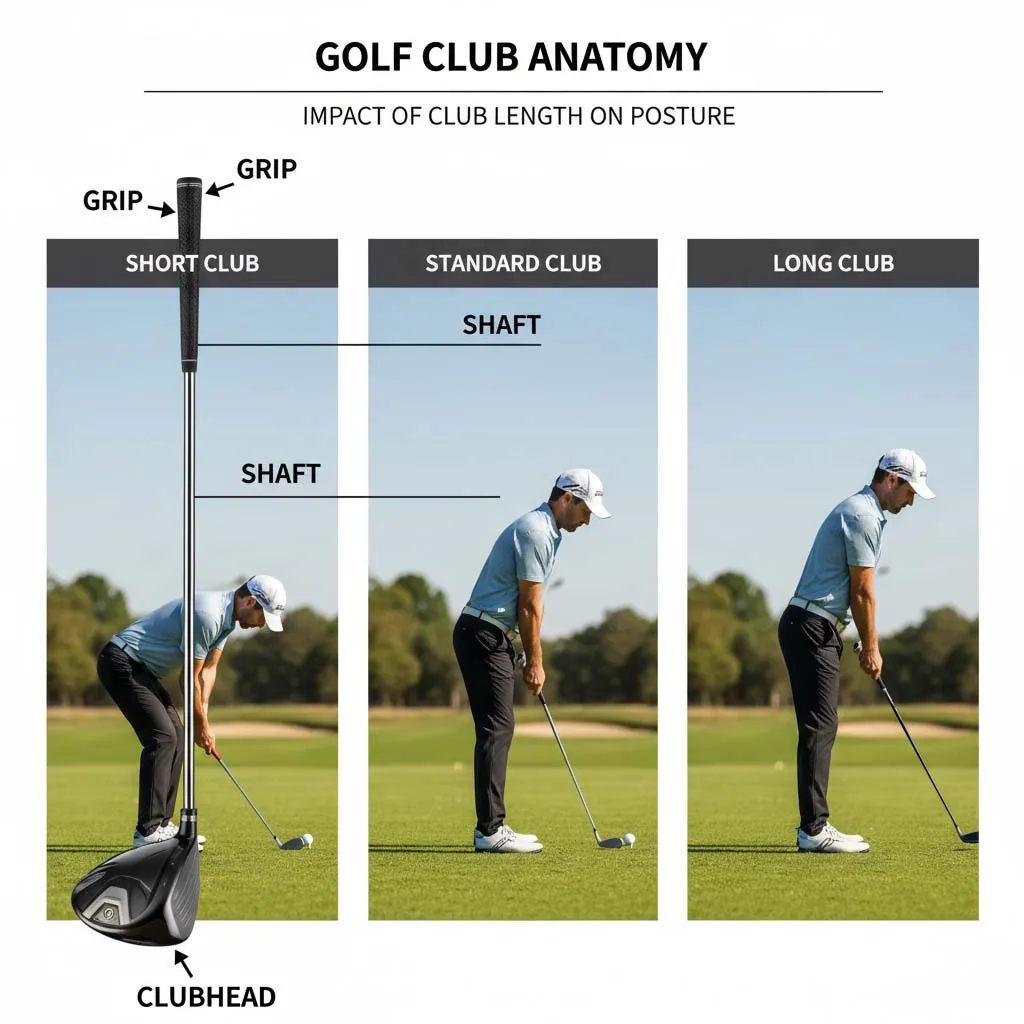
Posture and Balance
Club length has a direct impact on your posture and balance. Properly fitted clubs allow your arms to hang naturally and your spine to maintain a neutral, comfortable stance. This reduces tension in the shoulders, back, and wrists, enabling smoother swings.
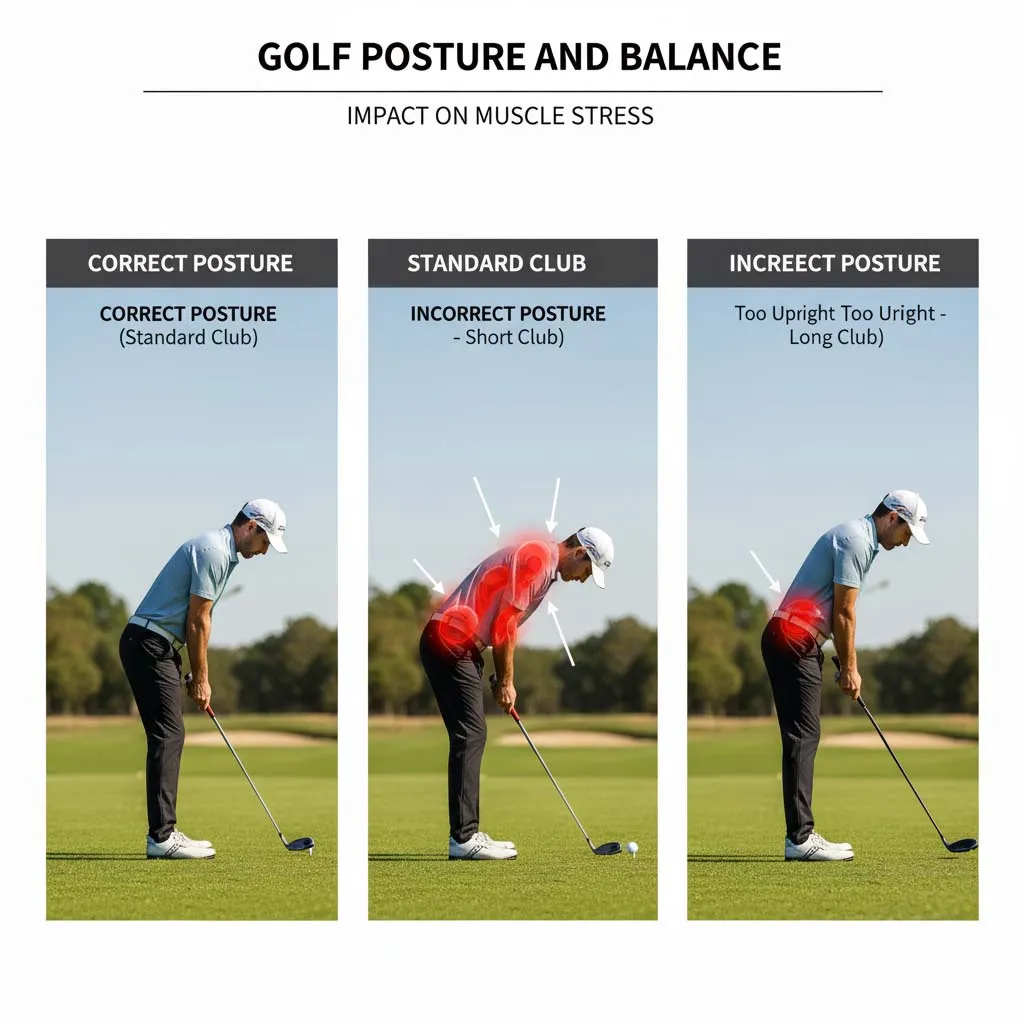
Conversely:
- Clubs that are too short: Force you to hunch, restricting your movement and reducing power. Over time, this can cause fatigue, inconsistent strikes, and strain on your back and shoulders.
- Clubs that are too long: Make you stand too upright, leading to control issues and off-center hits. Slices, hooks, and weak shots often result.
Benefits of Correct Club Length for Posture
- Maintains a balanced, natural stance
- Reduces strain on muscles and joints
- Supports a smooth, repeatable swing
Swing Mechanics
The length of your clubs directly influences your swing plane. Correctly sized clubs help maintain a consistent arc, ensuring proper energy transfer to the ball. Clubs that are too long or too short can force compensations, throwing off your mechanics and reducing accuracy.
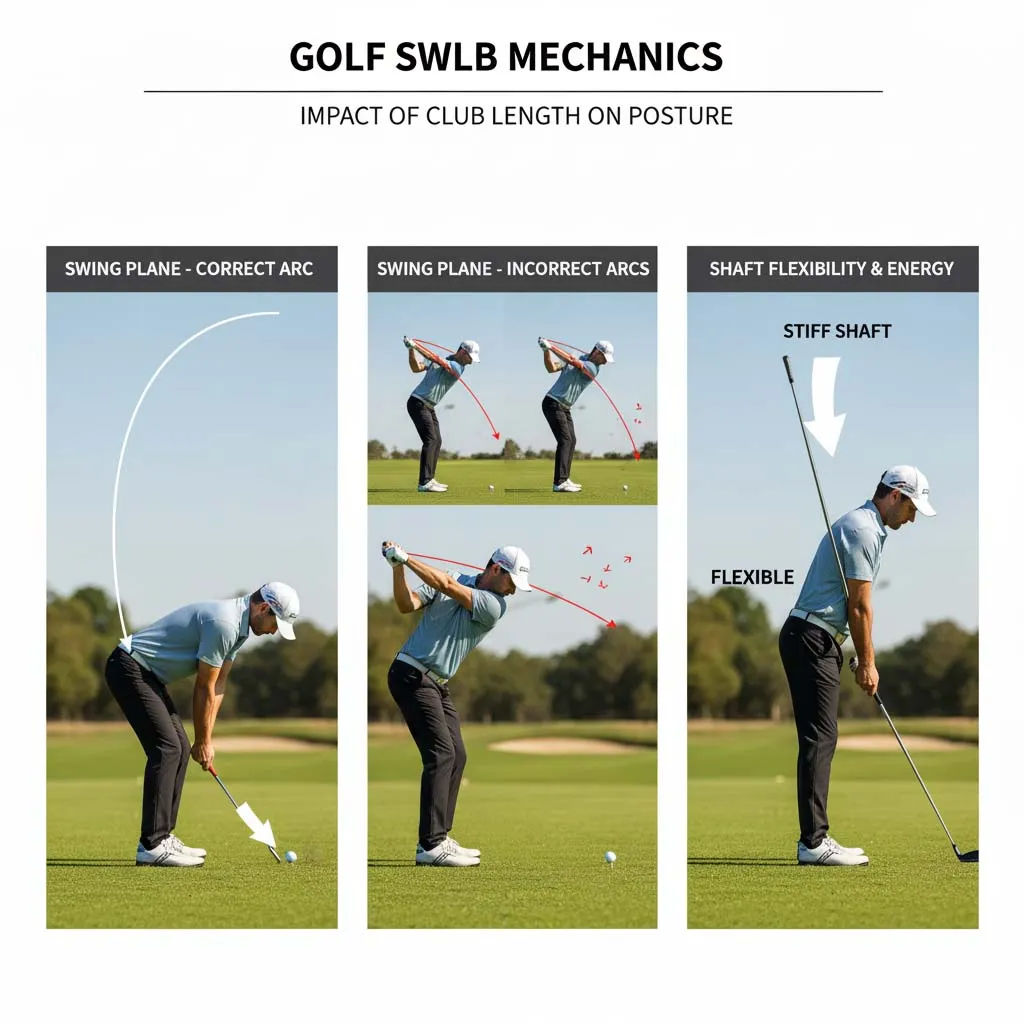
Shaft flexibility also affects swing mechanics:
- Too stiff: Harder to square the clubface, especially for slower swing speeds.
- Too flexible: Can cause inconsistent strikes and loss of control for faster swings.
- The right combination of shaft flex and club length maximizes energy transfer, control, and distance.
- Tools like a Golf Shaft Flex Calculator can help determine the ideal shaft flex based on your swing speed and style.
Contact and Accuracy
Using properly sized clubs increases your chances of consistently hitting the sweet spot. Adjusting the swing weight can improve control and confidence. Consider using a Swing Weight Calculator to find the optimal balance for your clubs. Even minor variations in length can affect ball trajectory, spin, and direction. Correct length allows your hands, arms, and shoulders to move naturally, giving you better control over every shot.
- Clubs that fit your body improve ball contact, trajectory, and distance.
- Proper club length also reduces unnecessary adjustments during swings.
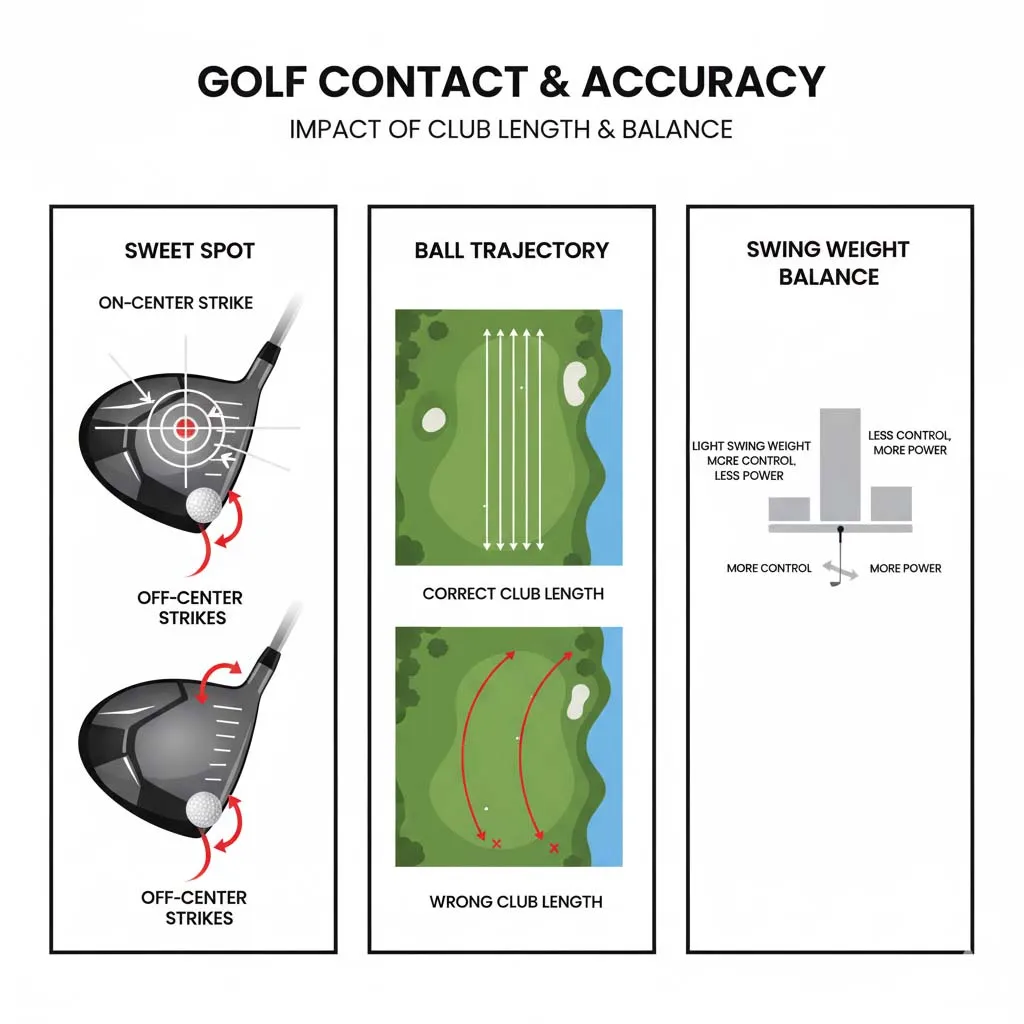
Control and Confidence
Beyond mechanics, the right club length builds confidence. Golfers who know their clubs fit well are less likely to overcompensate, which allows for relaxed swings, better accuracy, and more enjoyable play.
- Height adjustments: Tall golfers (over 6 feet) may need +0.5″ to +1″ added to the shaft, while shorter golfers might need -0.5″ to -1″.
- Correct club length supports your natural motion and builds confidence
- Wrong club length forces compensation, creates bad habits, and reduces performance
Types of Clubs and Their Ideal Size
Golf clubs are designed for different purposes, each with unique length requirements.
Drivers are the longest clubs, used for maximum distance off the tee. Standard driver length ranges from 43 to 45 inches. Beginners should prioritize control over distance, ensuring the driver allows a smooth, balanced swing without overextending.
Fairway woods are slightly shorter, typically 41 to 43 inches, for long shots from the fairway or rough. Their slightly shorter length allows better contact from various lies while maintaining power and trajectory.
Hybrids, often replacing long irons, measure 39 to 41 inches. Shorter than irons, hybrids are easier to control and help slower swingers make clean contact.
Irons vary in length depending on the number: 3-iron at 39 inches, down to 9-iron at 36 inches. These differences affect trajectory, distance, and control, so each iron should be tested for comfort and swing balance.
Wedges, including pitching and sand wedges, are short clubs between 35 and 36 inches, focusing on accuracy and precision around the green.
Putters typically range from 33 to 35 inches, with length adjustments based on stance, stroke type, and eye-line alignment over the ball. Proper putter length ensures a comfortable grip, correct posture, and consistent roll.
Standard Club Length Chart
| Club Type | Standard Length (inches) | Notes |
| Driver | 43–45 | Longest club for maximum distance |
| Fairway Wood | 41–43 | Slightly shorter for better control |
| Hybrid | 39–41 | Easier replacement for long irons |
| 3-Iron | 39 | Approach shots |
| 4-Iron | 38.5 | Slightly shorter for control |
| 5-Iron | 38 | Balanced for most golfers |
| 6-Iron | 37.5 | Comfort and swing arc |
| 7-Iron | 37 | Most common approach iron |
| 8-Iron | 36.5 | Accuracy-focused |
| 9-Iron | 36 | Precision approach |
| Pitching Wedge | 35.5 | Short club for control |
| Sand Wedge | 35–36 | Precision around green |
| Putter | 33–35 | Adjusted to stance and stroke |
These lengths are standard references. Individual adjustments may be required based on posture, swing, and comfort.
How to Measure Golf Club Length
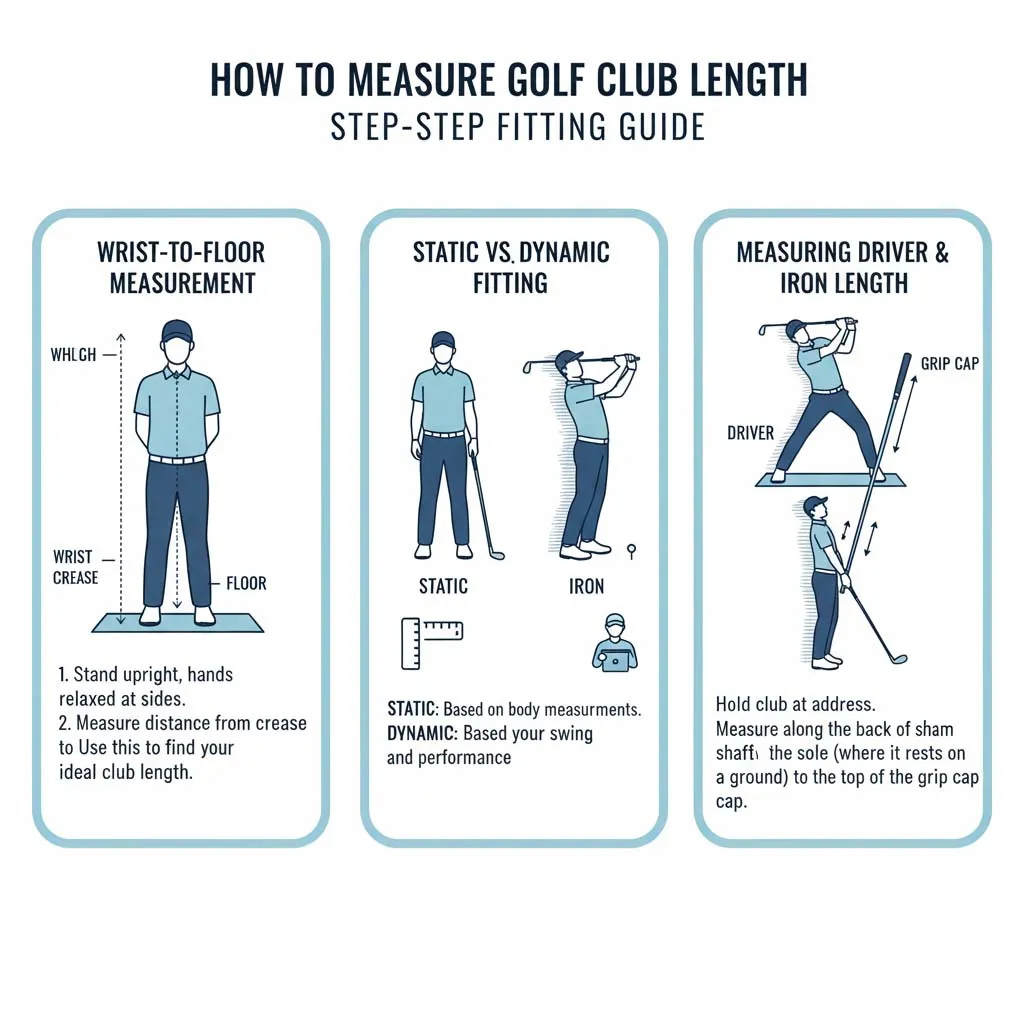
Static Measurement
One of the simplest methods to determine proper club length is the static measurement. In this method, a golfer stands upright with feet shoulder-width apart and arms naturally relaxed at their sides. A measurement is taken from the crease of the wrist to the floor, which provides a baseline for estimating club length. This method works well for beginners who are just starting out and need a general guideline before trying clubs on the course.
Wrist-to-Floor Measurement
The wrist-to-floor method is one of the most accurate ways to determine the correct club length for irons and wedges. It accounts for both the arm length and the torso height, providing a measurement that reflects how the body naturally positions itself over the ball. By using this measurement in conjunction with a sizing chart, golfers can select clubs that maintain proper posture and balance throughout the swing.
Driver Shaft Measurement
For drivers, it is essential to check comfort and swing mechanics. Grip the driver as you would during a normal swing, and observe whether you can maintain a natural stance without overextending or hunching. Proper driver length allows a full swing arc while keeping your body relaxed and aligned, which directly affects distance and accuracy.
Iron Shaft Measurement
Iron measurements are slightly different because they focus on precision and consistency. By placing irons flat on the ground and addressing the ball in a natural stance, golfers can evaluate whether the shaft length supports proper posture, swing plane, and ball contact. Adjustments may also be made to the lie angle to ensure consistent striking across different irons.
Using Sizing Charts
Once all measurements are taken, a sizing chart can provide a reference for standard club lengths based on height and wrist-to-floor distance. Golfers should view these charts as a guideline, then refine their selection through practice swings and actual play testing to ensure comfort, consistency, and proper ball contact.
Factors Influencing Club Selection
Player Height and Arm Length
While height is often considered, arm length and posture are equally important. Taller golfers may need slightly longer clubs to maintain proper setup, while shorter golfers benefit from shorter clubs that allow a balanced swing. The goal is to keep the body aligned, the arms hanging naturally, and the swing plane consistent.
Swing Speed and Mechanics
Swing speed plays a critical role in club selection. Slow or compact swings may benefit from slightly shorter clubs for better timing and control, while players with faster swings often need longer clubs to generate maximum distance. The mechanics of the swing, including tempo, follow-through, and wrist action, also influence the optimal club length.
Skill Level and Playing Style
Beginners generally prioritize comfort and consistency, focusing on repeatable swings rather than distance. Intermediate golfers look for a balance between control, distance, and accuracy, while advanced players fine-tune club length to achieve precise ball flight, trajectory, and shot shaping. Playing style, flexibility, and comfort all factor into the final club choice.
Custom Fitting Process
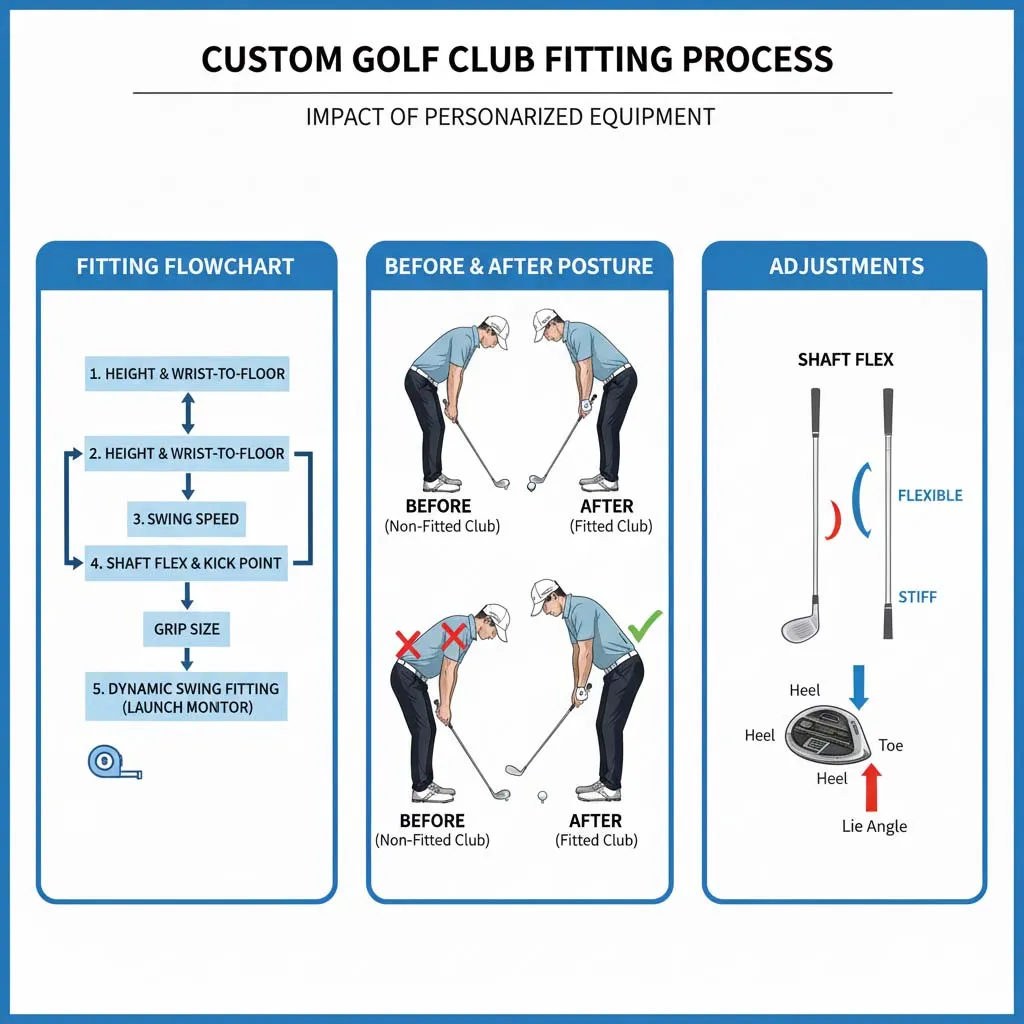
Swing Speed and Shaft Flex
A professional fitting begins with assessing swing speed using launch monitors, which helps determine the ideal shaft flex. Regular, stiff, or senior/ladies flex shafts allow for optimal energy transfer and control based on how fast a golfer swings the club.
Grip Size and Comfort
Grip size is evaluated during custom fitting to ensure hands are relaxed. A properly sized grip reduces tension, prevents fatigue, and allows for better control of the club. Improper grip size can negatively affect contact and consistency, regardless of the club’s length.
Adjusting Club Length and Lie Angle
Club length and lie angle adjustments are made to match the golfer’s natural posture and swing plane. The lie angle ensures the clubhead meets the ground correctly at impact, reducing slices and hooks, while the correct length allows for proper stance and swing mechanics.
Dynamic vs Static Fitting
Custom fitting often combines static and dynamic methods. Static fitting uses measurements like height, wrist-to-floor, and posture, while dynamic fitting monitors actual swings to assess ball flight, trajectory, and contact. By combining these approaches, golfers receive a set of clubs perfectly tailored to their swing style, comfort, and skill level, allowing for more consistent, accurate, and powerful shots on the course.
The Impact of Shaft Length on Your Swing
Shaft length affects distance, accuracy, and swing mechanics. Longer shafts can increase distance but may reduce control and consistency, while shorter shafts enhance accuracy at the cost of some distance. Choosing the right shaft length depends on swing speed, skill level, and comfort. For drivers, a longer shaft allows maximum arc and power; for irons, correct length ensures proper contact; and for wedges, precision and feel are prioritized. Balancing shaft length with comfort and mechanics is critical for improving overall performance.
Selecting Putters for Your Height
Putter length should allow a natural stance, with arms hanging comfortably and eyes aligned over the ball. The length should match the stroke type, whether straight-back-straight-through or arcing, to maintain consistent roll and control. Testing several putter lengths ensures comfort and accuracy, reducing unnecessary adjustments and promoting better distance control on the green.
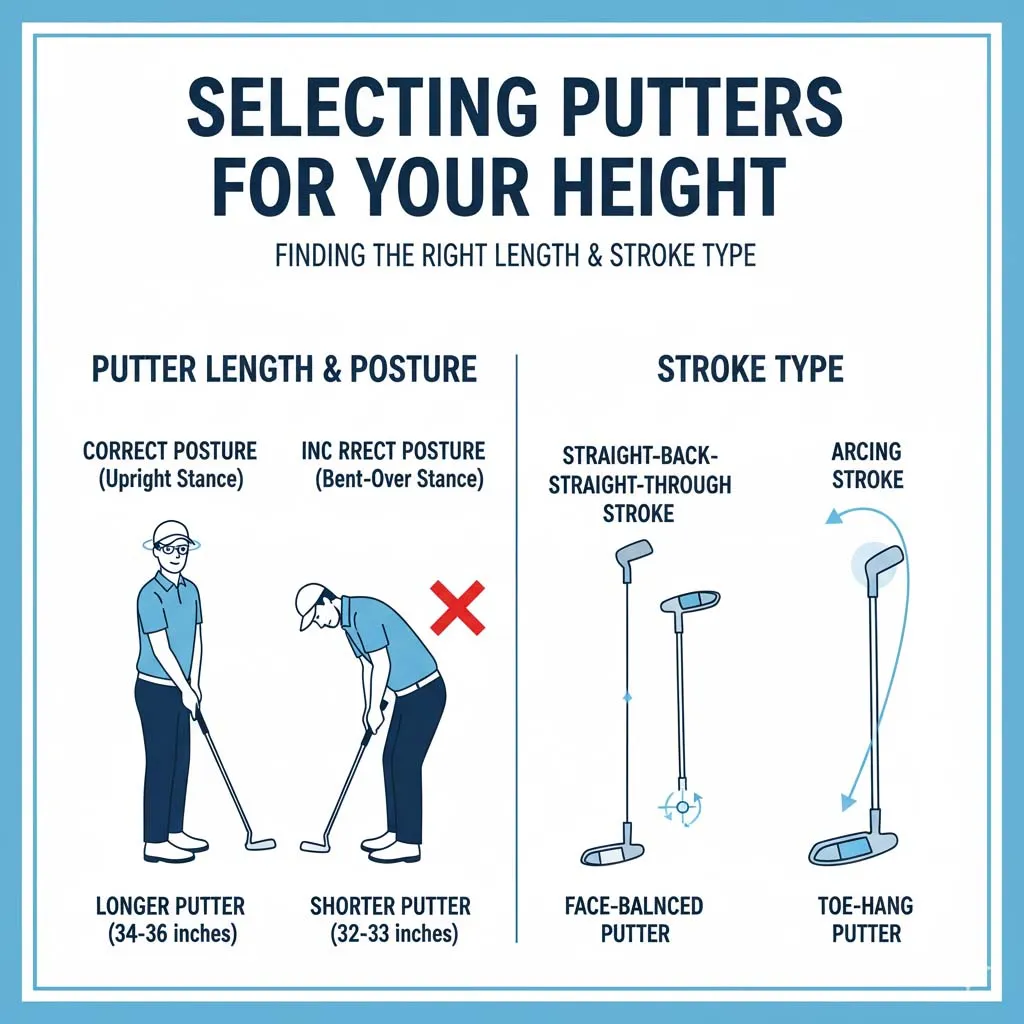
Common Mistakes and Myths
Many golfers believe taller players automatically need longer clubs or that longer clubs always generate more distance. These are misconceptions, as arm length, swing mechanics, and posture are more important than height. Beginners may assume they don’t need fitted clubs, but even basic measurements improve swing consistency, comfort, and overall performance. Avoid relying solely on online recommendations or standard sizes; testing and measurement are essential.
Final Thoughts
Choosing the right club length is fundamental to improving performance and comfort. Properly fitted clubs enhance posture, swing mechanics, ball contact, and confidence. Begin with measurements, use sizing charts, test clubs, and consider professional custom fitting. With the right clubs, your swing feels natural, shots are more consistent, and enjoyment of the game increases for players of all levels.
Golf Club Length FAQs
How do you know what size golf clubs to get?
To determine the right size, consider your height, arm length, posture, and swing mechanics. Begin with a wrist-to-floor measurement or consult a professional fitting. Trying different clubs at a driving range helps find the one that feels comfortable and allows a smooth, balanced swing.
What is the standard length of golf clubs?
Standard golf club lengths vary by club type. Drivers range from 43–45 inches, irons from 36–39 inches depending on the number, and putters from 33–35 inches. These serve as a guideline, but personal adjustments may improve comfort and performance.
Women’s golf club size chart / Petite women golf club set
Women’s clubs are usually lighter and shorter than men’s. For petite women (under 5’4”), shorter irons (35–36 inches), lighter shafts, and smaller grips allow a comfortable, controlled swing.
Are golf clubs based on height?
Height is one factor, but arm length, posture, and swing mechanics are more accurate determinants. Many fitting professionals use wrist-to-floor measurement for better results.
Can you adjust golf club length?
Yes. Most clubs can be shortened or lengthened slightly by a professional fitter to match posture, swing plane, and comfort. Lie angle and shaft flex can also be adjusted for optimal performance.
How long should my golf clubs be for my height?
Refer to height-based sizing charts. For example, a 5’9” man would typically use standard drivers (43–45 inches), irons (37–38 inches), and a putter (33–34 inches). Adjustments should be made based on swing mechanics and comfort.
How long should golf clubs be for beginners?
Use wrist-to-floor measurements and standard sizing charts. Comfort and control are more important than maximum distance.
Does height affect club length?
Height matters, but wrist-to-floor and posture measurements provide more accurate results.
Can you adjust the length of a golf club?
Most clubs can be shortened or lengthened slightly to improve fit.
Do women need shorter clubs?
Proper fit depends on height, arm length, posture, and swing, not gender.
What happens if clubs are too long?
They can cause balance issues, mis-hits, and difficulty controlling ball flight.
How do I know if my clubs are the wrong length?
Signs include awkward stance, repeated mis-hits, fatigue, and inconsistent shots
